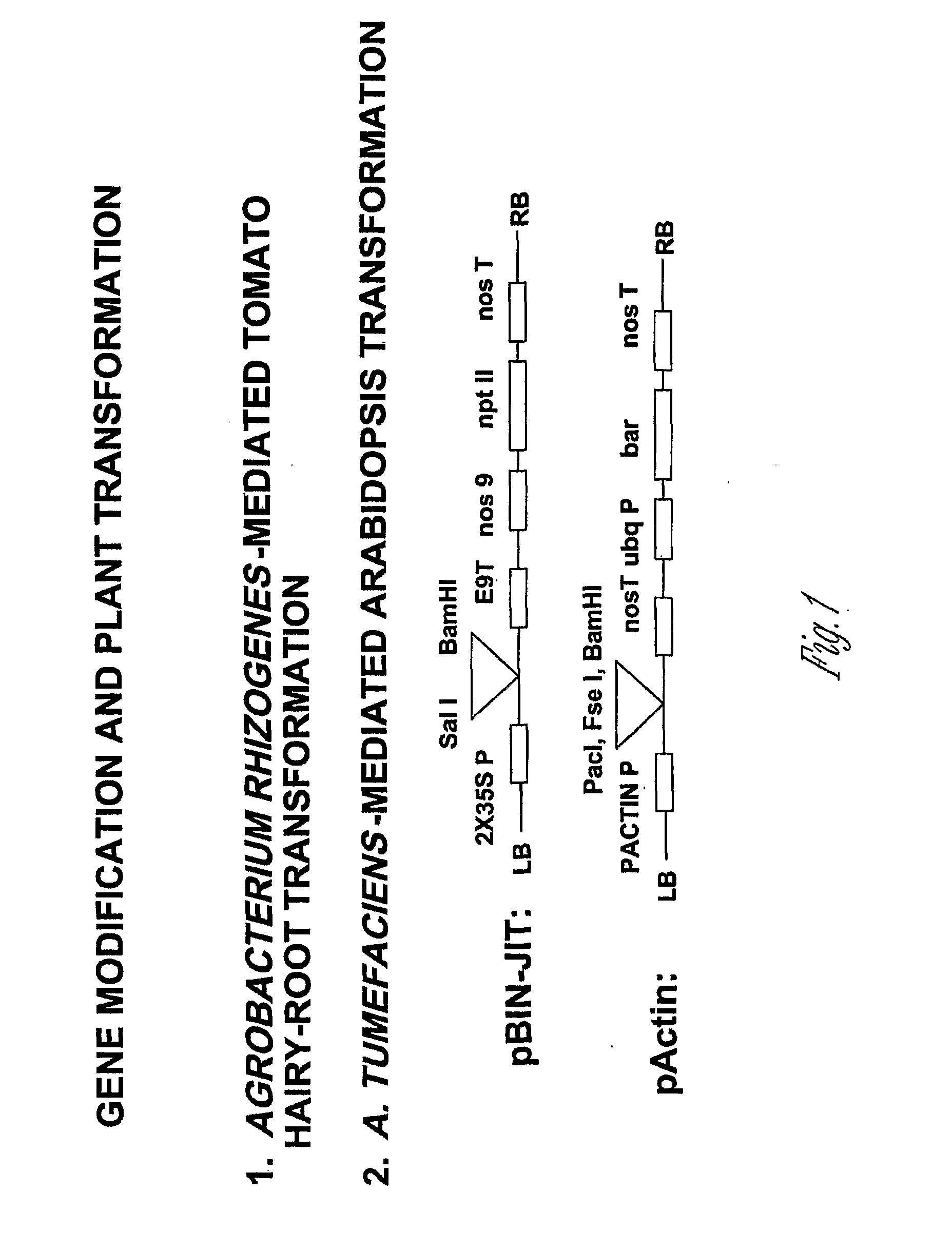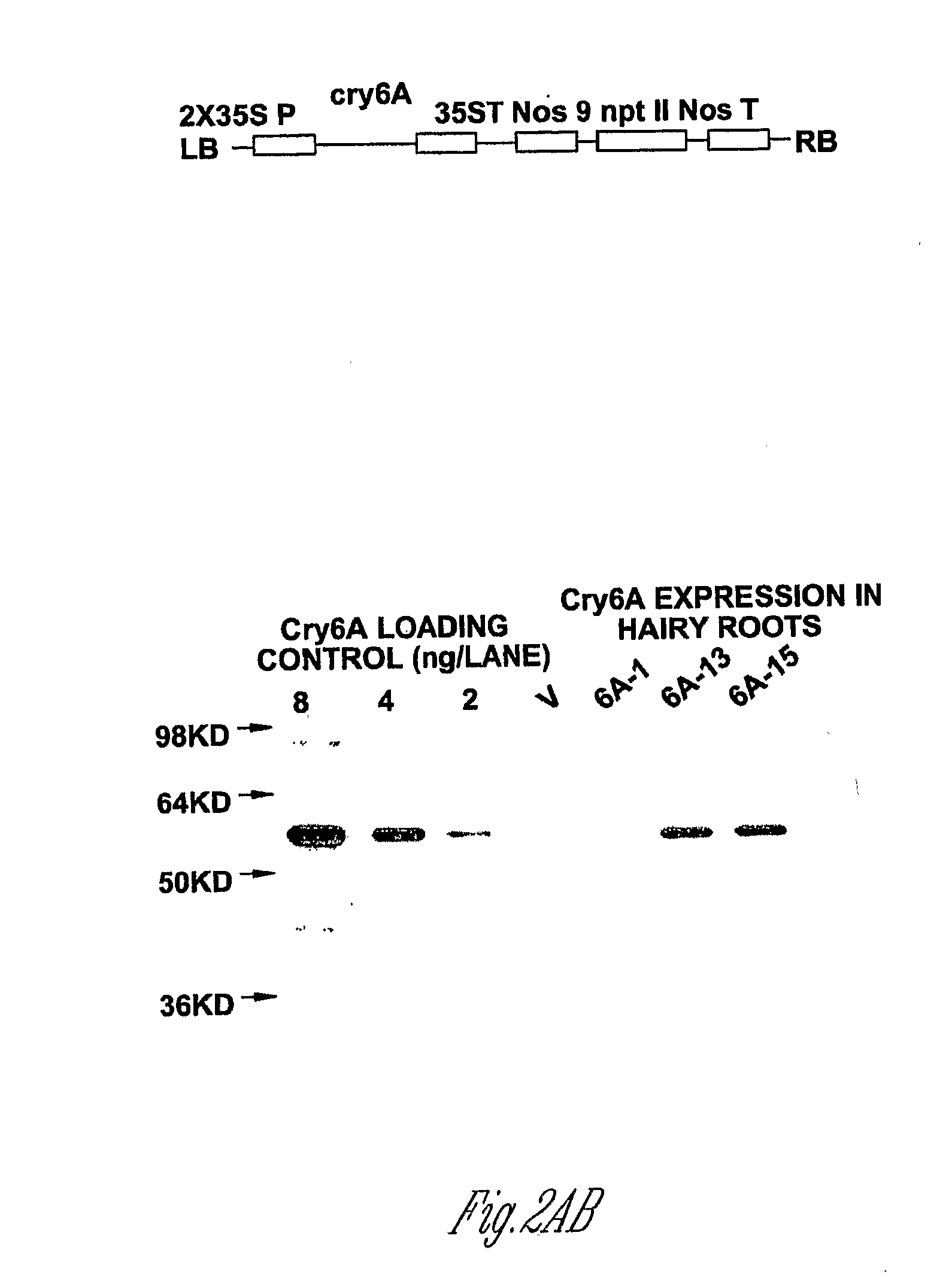Method for Controlling Plant-Parasitic Nematode Infections in Plants
a technology for plant parasites and nematodes, applied in the field of controlling plant parasite infections, can solve the problems of high toxicity to a variety of invertebrate species, and achieve the effects of increasing expression, safe and non-toxic, and increasing protein stability
- Summary
- Abstract
- Description
- Claims
- Application Information
AI Technical Summary
Benefits of technology
Problems solved by technology
Method used
Image
Examples
example i
[0108]Cry6A, a 475 residue protein (about 54 kD), is a potent nematicide against many free-living nematode species. In order to determine the minimal essential fragment necessary for activity, over thirty N-terminal and C-terminal truncations were made. Truncated Cry6A DNA sequences were synthesized by PCR using a series of internal primers. BamHI and PstI sites were incorporated into the primers to facilitate fragment recovery. The PCR products were then restriction digested and subcloned into the pQE9 expression vector and transformed into JM103 E. coli.
[0109]N-terminal truncations up to, but not including, amino acid residue 11 were effective against C. elegans. Likewise, C-terminal truncations up to, but not including, amino acid residue 382 were also nematicidal. Accordingly, the double truncation resulting in the Cry6A11-382 fragment was toxic to all free-living nematodes tested, e.g., C. elegans and Acrobeloides spp., except P. pacificus. The Cry6A11-382 fragment is estimate...
example ii
Methods
[0110]Gene synthesis and vector construction. Plant-version cry6A gene was synthesized by assembling the entire gene de novo from 70-90-mer oligonucleotides with Pfu Turbo DNA Polymerase (Stratagene) and cloning into the pBluescript KS (+) vector. The synthesized cry6A gene was then subcloned into the binary vector pBIN-JIT (Ferrandez, 2000) using SalI and BamHI cloning sites introduced at the 5′ and 3′ ends of the gene and placing cry6A expression under control of the double cauliflower mosaic virus 35S promoter (FIGS. 1 and 2A). Initially, no expression was seen and further modifications were made using the QuickChange multi site-directed mutagenesis kit (Stratagene). These additional changes include adding a plant translation initiation consensus site, which resulted in altering the second amino acid from Ile to Ala, and two prolines at the C-terminus. It was confirmed that bacterially-produced Cry6A with these amino acid alterations is still toxic to C. elegans and Aerobe...
example iii
Exemplary Mutagenesis Protocol
[0130]Cry5B is mutagenized (about 1-3 amino acid substitutions per gene) using a mutagenesis kit (Strategene). These mutated Cry5B clones, in an IPTG-inducible vector, are transformed into E. coli, and colonies are hand picked into a 96-well microtiter plate and grown overnight. Aliquots are pipetted onto four 24-well NG agar plates with IPTG, inducing expression of the clones. Mutant clones that express a hypertoxic Cry5B can be detected by looking for wells with worms that are sicker than control wells that contain non-mutated Cry5B after 6 days at 25° C.
[0131]1920 clones of random-mutagenized Cry5B clones were screened for those with increased toxicity. Twelve candidates were reconfirmed as hypertoxic based on the isolation of the plasmid with the mutated Cry5B, retransformation into a new E. coli strain (JM103), and retesting against wild-type Cry5B in JM103. SDS PAGE was carried out for 12 clones, and it was confirmed that all expressed normal (not...
PUM
| Property | Measurement | Unit |
|---|---|---|
| Fraction | aaaaa | aaaaa |
| Electrical conductance | aaaaa | aaaaa |
| Atomic weight | aaaaa | aaaaa |
Abstract
Description
Claims
Application Information
 Login to View More
Login to View More - R&D
- Intellectual Property
- Life Sciences
- Materials
- Tech Scout
- Unparalleled Data Quality
- Higher Quality Content
- 60% Fewer Hallucinations
Browse by: Latest US Patents, China's latest patents, Technical Efficacy Thesaurus, Application Domain, Technology Topic, Popular Technical Reports.
© 2025 PatSnap. All rights reserved.Legal|Privacy policy|Modern Slavery Act Transparency Statement|Sitemap|About US| Contact US: help@patsnap.com



